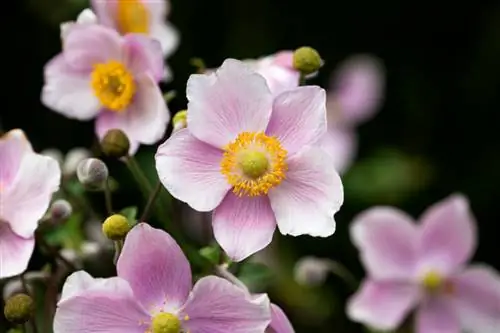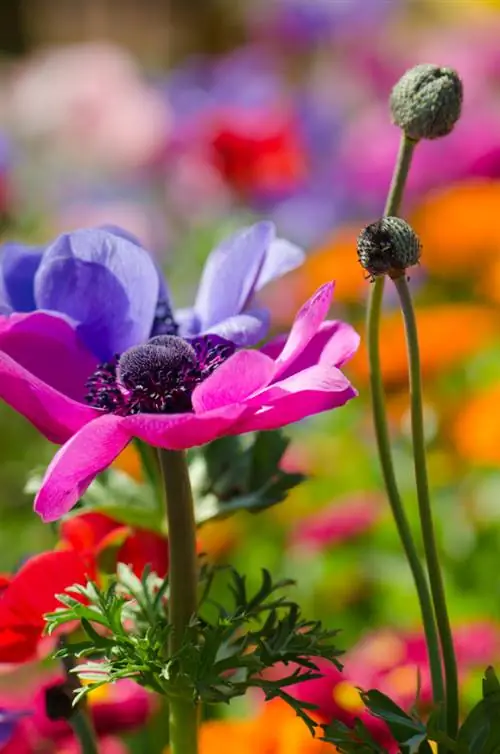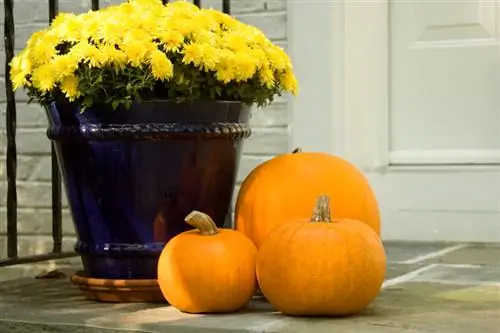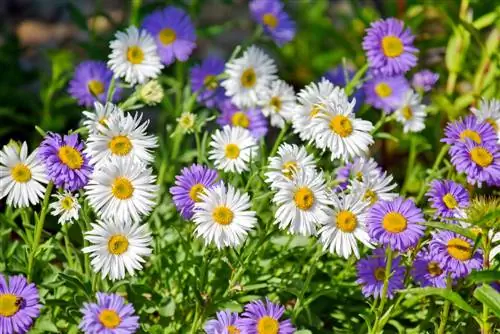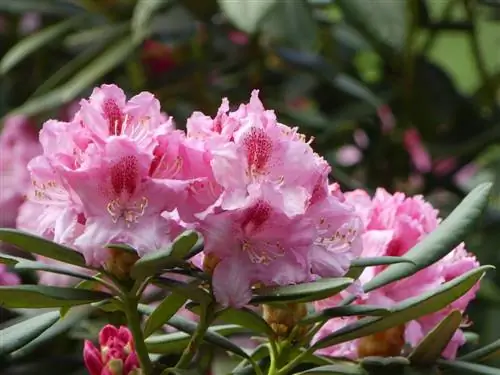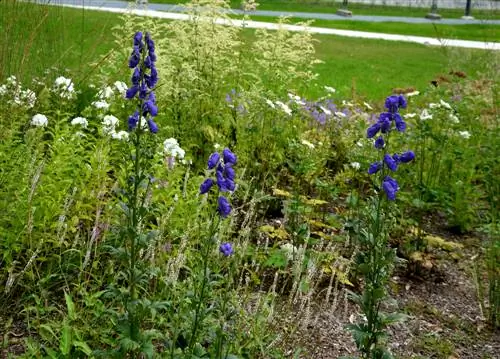- Author admin [email protected].
- Public 2023-12-25 17:45.
- Last modified 2025-01-23 11:22.
As the gardening year draws to a close, the hour of the autumn anemone strikes. The beauty of the flowers creates colorful accents in beds and pots well into October. Open questions about the correct cultivation of an Anemone hupehensis are addressed here in a concentrated manner.
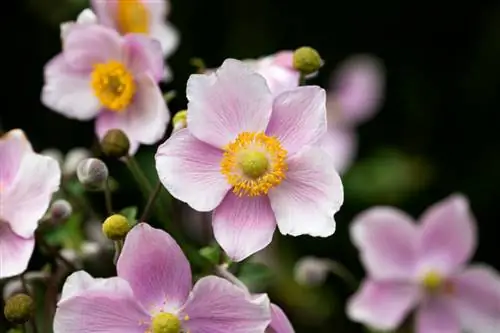
How to care for autumn anemones?
Autumn anemones (Anemone hupehensis) are easy-care, long-lasting perennials that bloom in beds and containers from August to October. They prefer a partially shaded, protected location and humus-rich, nutrient-rich soil. It is important to water regularly, apply organic fertilizer and remove wilted flowers to prolong the flowering period.
Planting autumn anemones correctly
The Anemone hupehensis proves to be a long-lasting and easy-care perennial if you take into account the requirements for the correct planting in the appropriate location. Following this quick guide you will definitely succeed:
- A partially shaded, protected location with humus-rich, nutritious soil is ideal
- The planting pit is twice as big as the root ball
- Improve the excavated soil with compost, leaf mold, guano and horn shavings
- The planting depth in the bed corresponds to that in the cultivation pot
- A perennial support gives tall growing anemone varieties the best stability
Water the young Anemone hupehensis and then mulch with leaves, compost or grass clippings. If you plant the autumn anemone in small tuffs, small islands of flowers form for a furious season finale. A planting distance of 45-50 cm for large perennials and 30-35 for smaller varieties is recommended.read more
Care tips
Complete compliance with all requirements for proper planting results in effortless care. The clear program in short form:
- Watering when the substrate has dried
- Fertilize organically every 2-3 weeks from May to September
- Clean out withered flowers, cut off withered leaves
- Pruning close to the ground in late winter
In the first two years of growth and in rough locations, we recommend winter protection in the bed. Cover the planting site with leaves, straw and pine fronds. Anemone hupehensis in the pot receives protection from frosty temperatures in the form of straw or leaves on the substrate in good time before the first frost. The planter is wrapped in bubble wrap and placed on insulating wood.read more
Which location is suitable?
If an adequate water supply is guaranteed at the location, the Anemone hupehensis thrives in sunny locations. If in doubt, we recommend a semi-shady location, for example in the shelter of tall deciduous trees. Since some specimens reach a height of 100 cm or more, a wind-protected position is of utmost importance.read more
The correct planting distance
Choose the planting distance proportional to the expected growth height. These distances have proven themselves in practice:
- Growth height 40-90 cm: planting distance 30-35 cm or 8 plants per square meter
- Growth height 90-140 cm: planting distance 45-50 cm or 4 plants per square meter
If the Anemone hupehensis serves as a backdrop plant in front of trees, we recommend a distance of 75 cm.
What soil does the plant need?
Autumn anemones are a hit in the bed wherever they have this type of soil:
- Nutritional, humic and freshly moist
- Preferably with a portion of clay
- Slight lime content is not a problem
- Good water drainage, without risk of waterlogging
As a substrate in the pot, we recommend a structurally stable compost-based potting soil, optimized with expanded clay or lava granules for good permeability. Adding a handful of ericaceous soil or peat prevents the pH value from becoming too high.
What is the best time to plant?
The autumn anemone first has to develop its winter hardiness in the bed. In order to give her a sufficient time window for this process, the planting time is primarily spring from mid/end of April.read more
When is flowering time?
The early autumn anemone develops its cup flowers from mid/late July until well into September. The majority of Anemone hupehensis blooms from August to October. The more consistently the perennial is cleaned out, the longer the flowers will last.
Cut autumn anemone correctly
Professional pruning regulates the duration of the flowering period, creates space for the young shoots and provides picturesque replenishment for home vase decorations. Our tips for proper cutting:
- Cleaning Anemone hupehensis regularly extends the flowering period
- Cut out wilted flowers if seed formation is not desired
- Pruning close to the ground only in late winter or early spring
- Cut flower stems for the vase early in the morning
read more
Watering autumn anemone
Keep the Anemone hupehensis constantly moist and avoid the formation of waterlogging. If you cultivate the perennial in a bucket, experience shows that the need for watering is higher than in the autumn bed. It is beneficial for the he alth of autumn anemones if you water them alternately with hard and soft water.
Fertilize autumn anemone properly
Anemone hupehensis requires repeated feeding of nutrients. Fertilize the bed with compost every 2-3 weeks from May to September. Potted plants receive a liquid fertilizer for flowering plants every 2 weeks.
Diseases
One of the pleasant characteristics of an Anemone hupehensis is its resistance to disease. Only sooty mold sometimes occurs as a result of an aphid infestation. This fungal disease manifests itself in black colored leaves. Cut the diseased flower back to the ground and dispose of the cuttings in the household waste.
Pests
The aphids that are omnipresent in the garden do not spare the Anemone hupehensis despite their poisonous content. If the little beasts frolic on the pretty perennial, repeated showering with the classic soft soap solution will put an end to them. Mix a tablespoon each of pure soft soap (€4.00 on Amazon) and spirit with a liter of water and spray the infected autumn anemone.
Wintering
Since the Anemone hupehensis gradually develops its winter hardiness in the first two years, we recommend these protective measures:
- Before the first frost, cover the root area with leaves and conifers
- Cover the pot with bubble wrap, place it on wood and cover the substrate with straw
Propagate autumn anemones
The lush blooms of an Anemone hupehensis awaken the desire for more specimens. The perennial offers several methods of propagation:
- Division of roots by separating runners in spring
- Separation of root cuttings in late autumn
Thanks to these uncomplicated propagation techniques, even advanced hobby gardeners decide against the complicated, lengthy sowing of seeds.
How do I transplant correctly?
With its long taproots, the Anemone hupehensis anchors itself deep in the ground. Damage to the root system when transplanting is therefore inevitable, which means the end of the magnificent perennial. Only consider changing location in exceptional cases. How to do it right:
- In the spring, after pruning, loosen the soil with the digging fork
- Cut off root strands that are too long within the radius of the average growth height with a spade
- Carefully lift the tuberous plant and the taproot out of the ground
So that the Anemone hupehensis grows again after transplanting, divide the rhizome into 2-4 segments with a sharp knife. It is also important to add a well-measured portion of compost to the new location.
Autumn anemone in a pot
The early Anemone hupehensis 'Praecox' and other delicate varieties thrive wonderfully in pots. Choose a container shape that offers enough space for the deep taproot. We recommend a high-quality compost-based potting soil as a substrate. A drainage made of potsherds above the floor opening prevents harmful waterlogging. How to care for the autumn anemone in the pot:
- Test the substrate every 2 days using the thumb sample
- If the soil surface feels dry, water it
- Apply a liquid fertilizer every 2 weeks from May to September
- Pinch out wilted flowers, cut out withered leaves
As the flowering period comes to an end, winter is just around the corner. Do not cut back the autumn anemone now, but only in late winter. Wrap the pot with bubble wrap, place it on a wooden block and cover the soil with needle sticks, straw or leaves. During a dry, frosty winter, water the Anemone hupehensis on mild days.
Is autumn anemone poisonous?
The botanical classification of Anemone hupehensis to the buttercup family rightly makes experienced hobby gardeners sit up and take notice. All members of this plant family are considered mildly toxic to humans and animals. Caution is therefore advised when within reach of small children and pets. We recommend wearing gloves when carrying out planting and care work.read more
Autumn anemone not blooming
If the flowering of an Anemone hupehensis takes a long time or fails completely, the following triggers cause the nuisance:
- Drought stress: keep the substrate constantly moist
- Overfertilization: it is better to fertilize organically with compost
- Waterlogging: Check the location, repot the potted plant and water less
Improper transplanting also leads to damage to the roots. In this case, there is no longer any salvation for the autumn anemone.
Brown leaves
If the leaves of an Anemone hupehensis turn brown, neglect in care usually caused this damage. Drought stress primarily results in dried, brown leaves. If the roots are in permanently moist soil, the foliage also turns brown. The same applies if the autumn anemone is at the mercy of constant autumn rain.
Yellow leaves
Yellow leaves are an alarm signal that the pH value of the soil is too high. Although the Anemone hupehensis accepts a slight lime content without any problems, a value of 7 should not be exceeded. As a result, the vital nutrient iron is bound in the substrate, causing deficiency symptoms that turn the foliage yellow. Fertilize specifically with an iron preparation from a specialist retailer and immediately water with decalcified tap water or collected rainwater.
The most beautiful varieties
- Alba: majestic, richly flowering and stable variety with creamy white flowers from August to October
- Queen Charlotte: elegant flower beauty with a height of 60-90 cm and delicate pink, semi-double flowers
- Rose bowl: the new variety impresses with dark pink flowers that are darker on the back and on the edge
- September Charm: recommended variety with petite 60 cm and pure pink cupped flowers
- Margarete: magnificent, semi-double flowers in bright red with a yellow eye and a height of 80 cm
- Honorine Jobert: historical variety from 1858, robust, long-lasting, richly flowering in bright white

